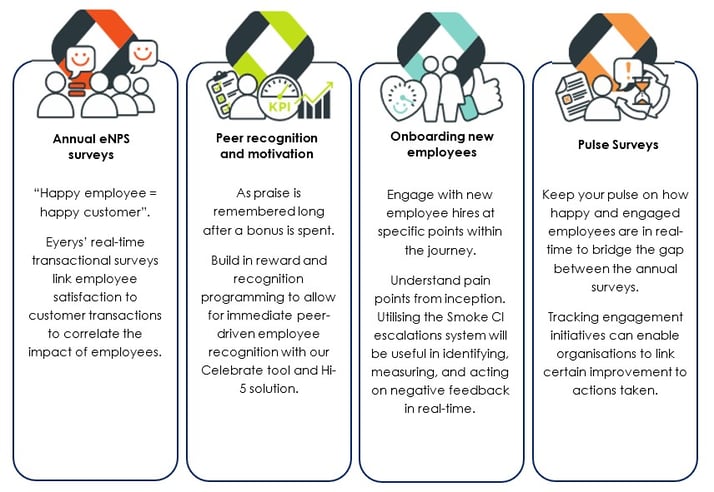Enhance Customer Intelligence: Engage Customers with WhatsApp Surveys
In the ever-evolving world of technology, new and exciting avenues emerge for businesses to gather valuable insights through the Voice of the...
3 min read
Michelle Sidambe : 29 November 2022

Providing a premium customer experience is only possible when delivered by an engaged, client-centric workforce. According to Kevin Kruse (CEO of LEADx), fully engaged employees contribute to higher service delivery which then leads to higher customer satisfaction, increased sales, and a 6% higher net profit margin. Employee engagement should, therefore, be a strategic focus for organisations seeking to gain a competitive edge. However, according to research done by MetLife, employee trends in 2022 indicate that job satisfaction is at an all-time low, almost 2 years after the pandemic.
Fortunately, providing a communication system that ensures a rapid flow of information from employees to HR is key in providing lasting positive effects in an organisation. This is, in most cases, facilitated by an engagement survey platform which can be conducted through several methodologies, however mainly successfully delivered online, SMS, and even by telephone. When correctly executed by an experienced team, these surveys can greatly benefit human resource teams (HR) and the organisation at large. It’s therefore critical to understand how engaged, happy, and loyal your employees really feel, and Smoke CI can help you enable these conversations.
Smoke CI’s Innovative ‘Engagement Employee Hub’ is focused on taking clients to new heights in their employee experience journey. Just some of those innovative solutions developed by Smoke CI include:

1. Provides the employee with a voice: Employee engagement surveys allow employees to voice their pain points, concerns, and overall needs. These surveys can be executed on an annual basis, however, there is also an opportunity to deploy more real-time surveys that bridge the gap between the time it takes for an employee to get the annual survey. These short targeted surveys can provide HR with a continuous picture of the effectiveness of the employee engagement strategies put in place.
2. Track and benchmark areas for improvement: Collecting and tracking employee results over time allows an organisation to reference historical data and understand the context behind a strategic engagement plan. One of the key benefits of using our Smoke CI platform ‘Eyerys’ is that you can see trended results over time which can be linked to different employee profiles such as the employee demographic, department, manager, and even location. Analysing data at such a granular level is incredibly valuable and can help inform the overall strategy. Organisations can also use the data to benchmark results which can help measure the impact of initiatives and identify opportunities for improvement. Additionally, an organisation can also compare its performance relative to similar businesses in the industry.
3. It is the vehicle that shapes the workplace: To create a workspace that employees love, HR must show that they are listening to the employee feedback and can take this feedback and help craft the best workplace culture that will allow them to flourish. By conducting employee engagement surveys, a business is communicating a clear message that they care about the well-being of employees and want to create the best environment for them.
1. Get buy-in from the top: A successful employee engagement strategy starts from the top down. Getting Manco/the top executive team's buy-in and involvement will help encourage participation and, inevitably, assist in higher response rate numbers. Make sure you partner with leadership in the rollout plan.
2. Ask the right questions: Identify questions that are aligned with the business process or topics of concern within the organisation. Partnering with managers and leaders who understand the business is imperative. Once you know which areas to cover, it is important to also word this correctly. Asking ambiguous surveys can harm your results and make it difficult to understand the true employee experience. Make sure questions are easy to understand by using simple language, ask one question at a time, and provide space for employees to leave their comments about their scores. Measuring outcome metrics such as eNPS and overall satisfaction within the employee experience also enables an overall understanding of the workforce, but also allows insight into the employee mindset within individual business units and departments. It may also be useful to compare employee, client, and agent results to understand similarities or divergences in terms of the different perspectives within the different stakeholder groups concerning the same experience or transaction.
3. Share your results and act: Once all results have been analysed and areas of improvement have been identified, it is important to present these results to employees. Also, indicate what changes will be made and give clear timelines of when these will be rolled out.
4. Lastly, do it all over again: Employee engagement is a continuous listening function as employee engagement evolves all the time. Therefore, deployment of these surveys should not be once off but a continuous cycle.

In the ever-evolving world of technology, new and exciting avenues emerge for businesses to gather valuable insights through the Voice of the...

It doesn’t matter which industry you’re in, if you have customers you need to provide a great customer experience. And make sure it’s what...

A long time ago in a galaxy far, far away… a space opera about humans, aliens, and droids engaged in an interplanetary war captivated, and continues...